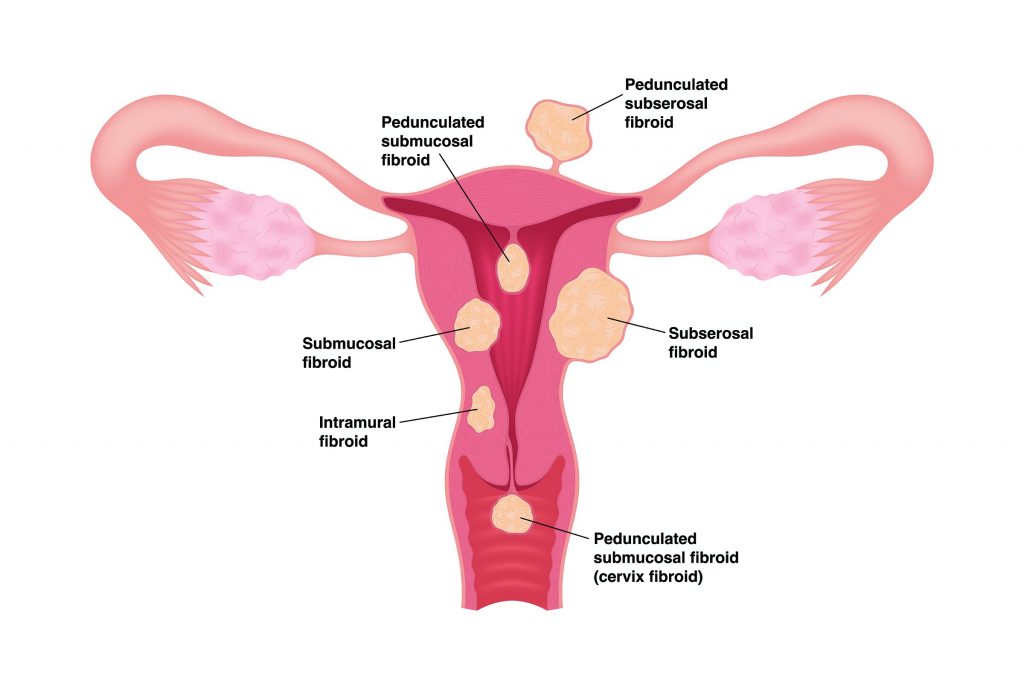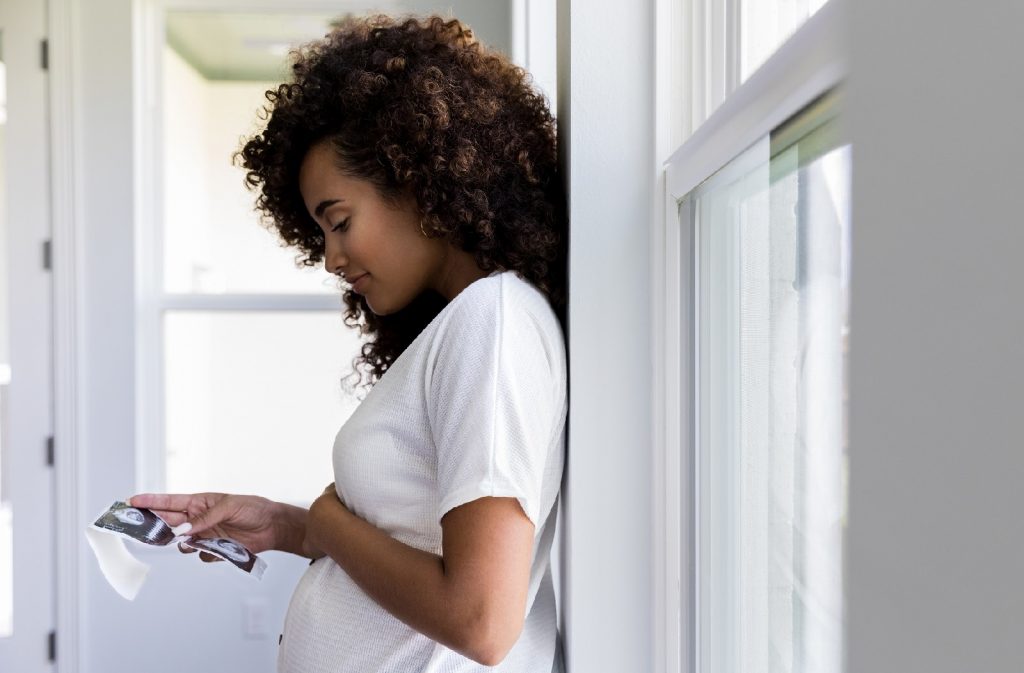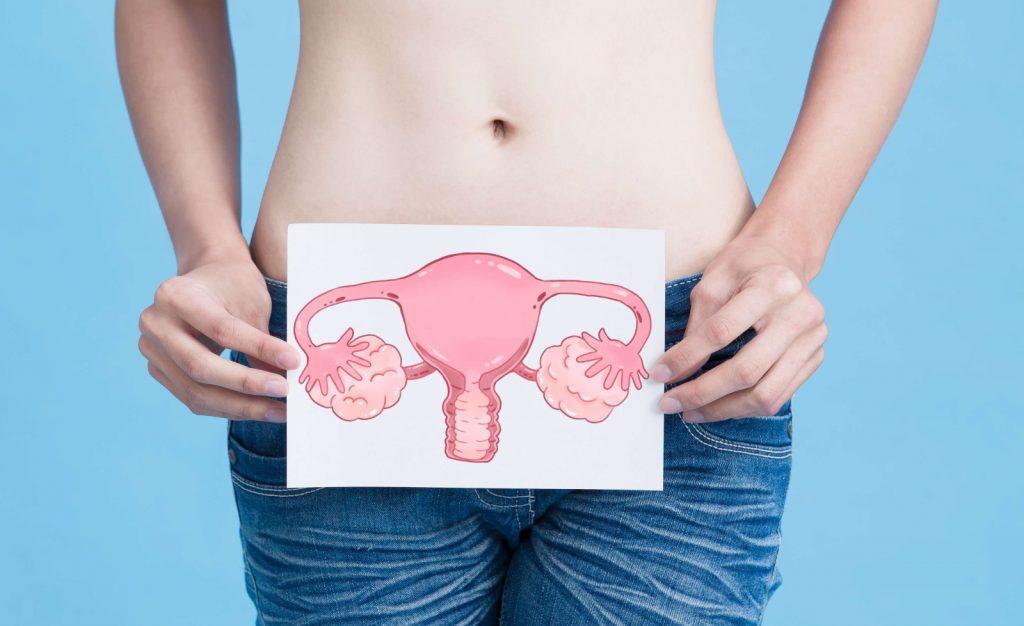When it comes to fibroids, location is key. We say that because while many women don’t know they have fibroids at first, fibroids can grow, multiply, and develop at different locations in and around the uterus. As a result, fibroids that pop up in certain locations may cause increasingly painful uterine fibroid symptoms and a host of other consequences that interrupt your daily life.
If you’ve been diagnosed with fibroids, it is important that you and your doctor keep a watchful eye. Even if immediate fibroid removal isn’t necessary, knowing the location of your fibroids may provide insight into your uterine fibroid symptoms and help you make more informed decisions.
What Are Fibroids and Where Can Fibroids Grow?
Fibroids are non-cancerous growths that develop from muscle tissue of the uterus. Most uterine fibroids are diagnosed in women between the ages of 35 and 54. However, fibroids can occur in women younger than 35 and until menopause. Depending on your situation, you may have one or several. In addition, they could all differ in size and either stay that way or grow at different rates.
Not all fibroids are painful by themselves. It is their size, growth rate, and location that can lead to problems. The sheer weight and location of fibroids force them to press against internal organs and nerves, leading to uterine fibroid symptoms such as:
- Heavy or inconsistent menstrual bleeding
- Abnormally long periods
- Back or leg pain
- Debilitating cramps, pelvic pain, and pressure
- Bowel or bladder disfunction
- Excessive fatigue and weight gain
- Pain during sex
- Urinary tract infections
- Bloating or swelling in the lower abdomen
- Constipation, diarrhea, and rectum discomfort
Fibroid location is a particular cause for concern for many women, especially those who are pregnant or intend to have children in the future. While having fibroids doesn’t mean that you can’t get pregnant, they could become quite a nuisance if left untreated and allowed to multiply and grow in more sensitive areas. The Office on Women’s Health breaks fibroids down into four main types depending on location.

Some cause more painful uterine fibroid symptoms than others and can also be more difficult to remove.
- Intramural fibroids — Grow inside the muscles of the uterine wall, causing issues with uterine function. Accounting for 70% of uterine fibroids, this is the most common affecting one in four of all women of childbearing age.
- Submucosal fibroids — Protrude underneath the uterine lining and into the uterine cavity, causing issues with uterine function. Some women notice heavy bleeding during menstruation and increased abdominal pain from this type of fibroid.
- Subserosal fibroids — Tend to grow just outside the uterine walls, impacting surrounding organs. As a result, these can put pressure on the bladder, bowels, and abdomen.
- Pedunculated fibroids — Hang by a thin thread or stalk inside or outside the uterus. These are more likely to cause pain in the abdominal area, due to obstruction of the uterus and surrounding organs.
Intramural and Submucosal Fibroid Issues
Intramural and submucosal fibroids have been known to significantly impact a woman’s ability to get pregnant simply because of their location. Any fibroid located in these areas can cause painful uterine fibroid symptoms, force a host of abnormal changes, and take a toll on fertility in several ways, including:
- Altering the cervix’s shape
- Stopping a fertilized egg from implanting properly in the uterus
- Hindering the number of sperm that can enter the uterus
- Abnormal blockage of the fallopian tubes
- Abnormal blood loss during delivery
- Dangerously affecting the baby’s positioning
- Limiting blood flow to the placenta, causing miscarriage
- Premature birth
- Increasing the chances of a cesarean section

Subserosal Fibroid Issues
Size and location of subserosal fibroids change the issues a woman may experience. As subserosal fibroids grow larger, they can result in:
- A protruding abdomen or belly
- Frequent urination
- Bloating
- Constipation
- Abdominal cramping or pain
- Difficulty emptying the bladder
- A heavy or full feeling in the abdomen

How Can You Stop Uterine Fibroid Symptoms?
The good news about fibroids and pregnancy is that while nearly every woman will develop fibroids in her lifetime, only 20% have symptoms. As a result, pregnancy complications as a direct result of having fibroids are generally not an issue. If a fibroid grows, it usually does so in the first 12 weeks of pregnancy.
With that said, many women still need a solution to annoying and often painful uterine fibroid symptoms. Many longtime go-to procedures like a hysterectomy may not be the right option for every woman. This is because a hysterectomy removes all or part of a woman’s uterus and, in some cases, the fallopian tubes and ovaries.
At Fibroid Institute Dallas, we are dedicated to treating fibroids and reducing fibroid symptoms without surgery. Uterine Fibroid Embolization (UFE) is a unique procedure because of its ability to treat uterine fibroid symptoms—regardless of where they are located—without having to go through a painful surgery and lengthy recovery time. Rather than remove fibroids, UFE uses diagnostic imaging tools and tiny particles to non-invasively stop blood supply to fibroids causing them to shrink and die. As a result, you have less pain and a quicker recovery time than surgery, all while reducing your fibroid symptoms. Just a few advantages of UFE include:
- No hospital stay
- Shorter recovery period (one week in some cases)
- No scarring
- All fibroids may be treated at the same time
- Dramatic reduction in fibroid symptoms
- Uterus is spared
- Over 90% effective
Thousands of women have had their fibroids symptoms treated with UFE by Dr. Suzanne Slonim, an award-winning fibroid doctor and founder of Fibroid Institute Dallas. Rated 5-stars with raving reviews by her patients, Dr. Slonim has performed over 30,000 procedures in 25+ years. She is voted as a top doctor by D Magazine, listed in Super Doctors by Texas Monthly, and honored with the Women in Business Award by the Dallas Business Journal.
Visit Our New Location at Fibroid Institute Dallas
Do you suffer from uterine fibroid symptoms? Knowing everything you possibly can about your fibroids, including where they are located, will go a long way in helping you and your doctor determine the right course of action.
Speaking of location, we have some exciting news! Fibroid Institute Dallas has expanded to help more women with fibroids. Our new location officially opened on March 8. Suzanne Slonim, MD is the #1 most experienced fibroid doctor in Dallas/Fort Worth specializing in Uterine Fibroid Embolization (UFE). The new location allows Dr. Slonim and the fibroid team to provide even better care with advanced diagnostic and procedure facilities.
Schedule your consult appointment and visit the new location at Hillcrest and I-635: 12840 Hillcrest Road, Suite #E104, Dallas, TX 75230. Or request a FREE phone screening to determine if you are eligible for the non-surgical fibroid treatment Uterine Fibroid Embolization (UFE). Most insurance companies cover the cost of UFE.
To learn more or to schedule, call 214-838-6440 or complete the form below.
This information is not a substitute for professional medical advice. Prior to starting any new treatment or if you have questions regarding a medical condition, always seek the advice of your doctor or other qualified health provider.
Fibroid Institute Dallas serves the DFW area including Addison, Carrollton, Plano, Frisco, McKinney, Allen, Fort Worth, Grand Prairie, HEB, Arlington, Hutchins, Irving, Duncanville, DeSoto, Cedar Hill, Lancaster, Cockrell Hill, Highland Park, University Park, Park Cities, Garland, Mesquite, Richardson, Dallas, and all of North Texas.

